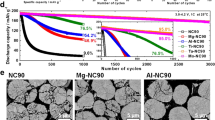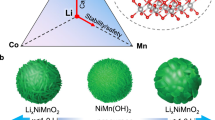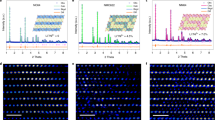Abstract
The elimination of Co from Ni-rich layered cathodes is considered a priority to reduce their material cost and for sustainable development of Li-ion batteries (LIBs) as Co is becoming increasingly scarce. The introduction of 1 mol% Mo into Li(Ni0.9Mn0.1)O2 delivers 234 mAh g−1 at 4.4 V. The cycling stability of a full cell featuring the Li(Ni0.89Mn0.1Mo0.01)O2 (Mo–NM90) cathode is enhanced with a modified electrolyte; retaining 86% of its initial capacity after 1,000 cycles while providing 880 Wh kgcathode−1. The grain size refinement achieved by Mo doping dissipates the deleterious strain from abrupt lattice contraction through fracture toughening and the removal of local compositional inhomogeneities. Enhanced cation ordering induced by the presence of Mo6+ also stabilizes the delithiated structure through a pillar effect. The Mo–NM90 cathode is able to deliver a high capacity with cycling stability suitable for the long service life for electric vehicles at a reduced material cost, furthering the realization of a commercially viable Co-free cathode for LIBs.
This is a preview of subscription content, access via your institution
Access options
Access Nature and 54 other Nature Portfolio journals
Get Nature+, our best-value online-access subscription
$29.99 / 30 days
cancel any time
Subscribe to this journal
Receive 12 digital issues and online access to articles
$119.00 per year
only $9.92 per issue
Buy this article
- Purchase on Springer Link
- Instant access to full article PDF
Prices may be subject to local taxes which are calculated during checkout





Similar content being viewed by others
Data availability
All the relevant data are included in the paper and its Supplementary Information.
References
Schmuch, R., Wagner, R., Hörpel, G., Placke, T. & Winter, M. Performance and cost of materials for lithium-based rechargeable automotive batteries. Nat. Energy 3, 267–278 (2018).
Naceur, K. B. Tracking Clean Energy Progress (International Energy Agency, 2016).
Andre, D. et al. Future generations of cathode materials: an automotive industry perspective. J. Mater. Chem. A 3, 6709–6732 (2015).
2020 Annual Merit Review, Vehicle Technologies Office (US Department of Energy, 2020); https://www.energy.gov/sites/prod/files/2020/06/f75/bat317_liu_2020_o_4.22.20_148PM_LR.pdf
Kittner, N., Lill, F. & Kammen, D. M. Energy storage deployment and innovation for the clean energy transition. Nat. Energy 2, 17125 (2017).
Cobalt London Metal Exchange https://www.lme.com/en/Metals/EV/LME-Cobalt# (2022).
Nkulu, C. B. L. et al. Sustainability of artisanal mining of cobalt in DR Congo. Nat. Sustain. 1, 495–504 (2018).
Alves Dias, P., Blagoeva, D., Pavel, C. & Arvanitidis, N. Cobalt: Demand–Supply Balances in the Transition to Electric Mobility. EUR 29381 EN (Publications Office of the European Union, 2018); https://doi.org/10.2760/97710
Delmas, C., Saadoune, I. & Rougier, A. The cycling properties of the LixNi1−yCoyO2 electrode. J. Power Sources 44, 595–602 (1993).
MacNeil, D. D., Lu, Z. & Dahn, J. R. Structure and electrochemistry of Li[NixCo1−2xMnx]O2 (0 ≤ x ≤ 1/2). J. Electrochem. Soc. 149, A1332–A1336 (2002).
Sun, H.-H., Choi, W., Lee, J. K., Oh, I.-H. & Jung, H.-G. Control of electrochemical properties of nickel-rich layered cathode materials for lithium ion batteries by variation of the manganese to cobalt ratio. J. Power Sources 275, 877–883 (2015).
Aishova, A., Park, G.-T., Yoon, C. S. & Sun, Y.-K. Cobalt-free high-capacity Ni-rich layered Li[Ni0.9Mn0.1]O2 cathode. Adv. Energy Mater. 10, 1903179 (2019).
Li, M. & Lu, J. Cobalt in lithium-ion batteries. Science 367, 979–980 (2020).
Ryu, H.-H., Sun, H.-H., Myung, S.-T., Yoon, C. S. & Sun, Y.-K. Reducing cobalt from lithium-ion batteries for the electric vehicle era. Energy Environ. Sci. 14, 844–852 (2021).
Li, H. et al. Is cobalt needed in Ni-rich positive electrode materials for lithium ion batteries? J. Electrochem. Soc. 166, A429–A439 (2019).
Mu, L. et al. Dopant distribution in Co-free high-energy layered cathode materials. Chem. Mater. 31, 9769–9776 (2019).
Li, W., Lee, S. & Manthiram, A. High-nickel NMA: a cobalt-free alternative to NMC and NCA cathodes for lithium-ion batteries. Adv. Mater. 32, 2002718 (2020).
Ohzuku, T. & Makimura, Y. Layered lithium insertion material of LiNi1/2Mn1/2O2: a possible alternative to LiCoO2 for advanced lithium-ion batteries. Chem. Lett. 30, 744–745 (2001).
Yabuuchi, N., Kim, Y.-T., Li, H. H. & Shao-Horn, Y. Thermal instability of cycled LixNi0.5Mn0.5O2 electrodes: an in situ synchrotron X-ray powder diffraction study. Chem. Mater. 20, 4936–4951 (2008).
Sun, Y.-K., Lee, D.-J., Lee, Y. J., Chen, Z. & Myung, S.-T. Cobalt-free nickel rich layered oxide cathodes for lithium-ion batteries. ACS Appl. Mater. Interfaces 5, 11434–11440 (2013).
Li, L. et al. Atomic-scale mechanisms of enhanced electrochemical properties of Mo-doped Co-free layered oxide cathodes for lithium-ion batteries. ACS Energy Lett. 4, 2540–2546 (2019).
Liu, T. et al. Understanding Co roles towards developing Co-free Ni-rich cathodes for rechargeable batteries. Nat. Energy 6, 277–286 (2021).
Van der Ven, A., Bhattacharya, J. & Belak, A. A. Understanding Li diffusion in Li-intercalation compounds. Acc. Chem. Res. 46, 1216–1225 (2013).
Hong, C. et al. Revealing the correlation between structural evolution and Li+ diffusion kinetics of nickel-rich cathode materials in Li-ion batteries.J. Mater. Chem. A 8, 8540 (2020).
Park, G.-T. et al. Ultrafine-grained Ni-rich layered cathode for advanced Li-ion batteries. Energy Environ. Sci. 14, 6616–6626 (2021).
Zang, Y., Ding, C.-X., Wang, X.-C., Wen, Z.-Y. & Chen, C.-H. Molybdenum-doped lithium-rich layered-structured cathode material Li1.2Ni0.2Mn0.6O2 with high specific capacity and improved rate performance. Electrochim. Acta 168, 234–239 (2015).
Breuer, O. et al. Understanding the role of minor molybdenum doping in LiNi0.5Co0.2Mn0.3O2 electrodes: from structural and surface analyses and theoretical modeling to practical electrochemical cells. ACS Appl. Mater. Interfaces 10, 29608–29621 (2018).
Susai, F. A. et al. Improving performance of LiNi0.8Co0.1Mn0.1O2 cathode materials for lithium-ion batteries by doping with molybdenum-ions: theoretical and experimental studies. ACS Appl. Energy Mater. 2, 4521–4534 (2019).
Darbar, D. et al. New synthesis strategies to improve Co-free LiNi0.5Mn0.5O2 cathodes: early transition metal d0 dopants and manganese pyrophosphate coating. J. Power Sources 479, 228591 (2020).
Li, Y. et al. Synthesis and characterization of Mo-doped LiNi0.5Co0.2Mn0.3O2 cathode materials prepared by a hydrothermal process. Ceram. Int. 43, 3483–3488 (2017).
Yoon, C. S. et al. Cation ordering of Zr-doped LiNiO2 cathode for lithium-ion batteries. Chem. Mater. 30, 1808–1814 (2018).
Kim, U.-H. et al. Cation ordered Ni-rich layered cathode for ultra-long battery life. Energy Environ. Sci. 14, 1573–1583 (2021).
Kim, U.-H. et al. Heuristic solution for achieving long-term cycle stability for Ni-rich layered cathodes at full depth of discharge. Nat. Energy 5, 860–869 (2020).
Li, H. H. et al. Changes in the cation ordering of layered O3 LixNi0.5Mn0.5O2 during electrochemical cycling to high voltages: an electron diffraction study. Chem. Mater. 19, 2551–2565 (2007).
Ohzuku, T., Ueda, A. & Nagayama, M. Electrochemistry and structural chemistry of LiNiO2 (R3m) for 4 volt secondary lithium cells. J. Electrochem. Soc. 140, 1862–1870 (1993).
Ryu, H.-H., Park, K.-J., Yoon, C. S. & Sun, Y.-K. Capacity fading of Ni-rich Li[NixCoyMn1–x–y]O2 (0.6 ≤ x ≤ 0.95) cathodes for high-energy-density lithium-ion batteries: bulk or surface degradation?. Chem. Mater. 30, 1155–1163 (2018).
Ryu, H.-H. et al. Microstrain alleviation in high-energy Ni-rich NCMA cathode for long battery life. ACS Energy Lett. 6, 216–223 (2021).
Park, G.-T. et al. High-performance Ni-rich Li[Ni0.9–xCo0.1Alx]O2 cathodes via multi-stage microstructural tailoring from hydroxide precursor to the lithiated oxide. Energy Environ. Sci. 14, 5084–5095 (2021).
Yang, S., Yan, B., Lu, L. & Zeng, K. Grain boundary effects on Li-ion diffusion in a Li1.2Co0.13Ni0.13Mn0.54O2 thin film cathode studied by scanning probe microscopy techniques. RSC Adv. 6, 94000–94009 (2016).
Schwab, C. et al. Bulk and grain boundary Li-diffusion in dense LiMn2O4 pellets by means of isotope exchange and ToF-SIMS analysis. Phys. Chem. Chem. Phys. 21, 26066–26076 (2019).
Xiao, Y. et al. Insight into the origin of lithium/nickel ions exchange in layered Li(NixMnyCoz)O2 cathode materials. Nano Energy 49, 77–85 (2018).
Yoon, C. S., Jun, D.-W., Myung, S.-T. & Sun, Y.-K. Structural stability of LiNiO2 cycled above 4.2 V. ACS Energy Lett. 2, 1150–1155 (2017).
Alvarado, J. et al. A carbonate-free, sulfone-based electrolyte for high-voltage Li-ion batteries. Mat. Today 21, 341–353 (2018).
Hagos, T. T. et al. Developing high-voltage carbonate-ether mixed electrolyte via anode-free cell configuration. J. Power Sources 461, 228053 (2020).
Klein, S. et al. Understanding the outstanding high-voltage performance of NCM523||graphite lithium ion cells after elimination of ethylene carbonate solvent from conventional electrolyte. Adv. Energy Mater. 11, 2003738 (2021).
Nguyen, C. C. & Lucht, B. L. Comparative study of fluoroethylene carbonate and vinylene carbonate for silicon anodes in lithium ion batteries. J. Electrochem. Soc. 161, A1933–A1938 (2014).
Zhu, Z. et al. Fluoroethylene carbonate enabling a robust LiF-rich solid electrolyte interphase to enhance the stability of the MoS2 anode for lithium-ion storage. Angew. Chem. 130, 3718–3722 (2018).
Park, S.-J., Hwang, J.-Y., Yoon, C. S., Jung, H.-G. & Sun, Y.-K. Stabilization of lithium-metal batteries based on the in situ formation of a stable solid electrolyte interphase layer. ACS Appl. Mater. Interfaces 10, 17985–17993 (2018).
Markevich, E. et al. High-performance LiNiO2 cathodes with practical loading cycled with Li metal anodes in fluoroethylene carbonate-based electrolyte solution. ACS Appl. Energy Mater. 1, 2600–2607 (2018).
Lee, Y. et al. Fluorine-incorporated interface enhances cycling stability of lithium metal batteries with Ni-rich NCM cathodes. Nano Energy 67, 104309 (2020).
Rueden, C. T. et al. ImageJ2: imageJ for the next generation of scientific image data. BMC Bioinf. 18, 529 (2017).
Acknowledgements
This work was mainly supported by the Human Resources Development Program (number 20214000000320) of the Korea Institute of Energy Technology Evaluation and Planning (KETEP) grant, funded by the Ministry of Trade, Industry and Energy of the Korean government. This work was also supported by National Research Foundation of Korea (NRF) grant funded by the Korea government Ministry of Education and Science Technology (MEST) (NRF-2018R1A2B3008794).
Author information
Authors and Affiliations
Contributions
G.-T.P., C.S.Y. and Y.-K.S. conceived and designed the research. G.-T.P., B.N. and S.-B.K. performed the experiments and characterization of materials. G.-T.P., C.S.Y. and Y.-K.S. analysed the data. G.-T.P., J.L., C.S.Y. and Y.-K.S. contributed to the discussion of the results. C.S.Y. and Y.-K.S. wrote the manuscript. All the authors commented on and revised the manuscript.
Corresponding authors
Ethics declarations
Competing interests
The authors declare no competing interests.
Peer review
Peer review information
Nature Energy thanks Samuel Booth, Minghao Zhang and the other, anonymous, reviewer(s) for their contribution to the peer review of this work.
Additional information
Publisher’s note Springer Nature remains neutral with regard to jurisdictional claims in published maps and institutional affiliations.
Supplementary information
Supplementary Information
Supplementary References 1–13, Figs. 1–30 and Tables 1–5.
Rights and permissions
Springer Nature or its licensor holds exclusive rights to this article under a publishing agreement with the author(s) or other rightsholder(s); author self-archiving of the accepted manuscript version of this article is solely governed by the terms of such publishing agreement and applicable law.
About this article
Cite this article
Park, GT., Namkoong, B., Kim, SB. et al. Introducing high-valence elements into cobalt-free layered cathodes for practical lithium-ion batteries. Nat Energy 7, 946–954 (2022). https://doi.org/10.1038/s41560-022-01106-6
Received:
Accepted:
Published:
Issue Date:
DOI: https://doi.org/10.1038/s41560-022-01106-6



